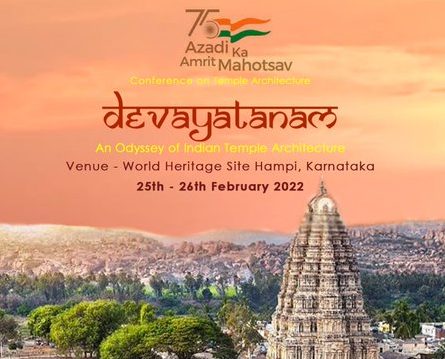‘Devayatanam’ – An Odyssey of Indian Temple Architecture
The Archaeological Survey of India (ASI) of Ministry of Culture is organizing a two-day international conference ‘Devayatanam’ – An odyssey of Indian temple architecture during 25th - 26th February, 2022 at Hampi, Karnataka.

Aim of the Conference
- The conference aims to deliberate upon the philosophical, religious, social, economic, technical, scientific, art and architectural aspects of temple.
- It also intends to initiate a dialogue on the evolution and development of the various styles of temple architecture.
Three Main Styles of Temple Architecture
- There are three main kinds of temple architecture in India: Nagara or the Northern Style, Dravida or the Southern style, and Vesara or the Mixed styles.
| A Brief on different Temple Architecture Styles |
| Nagara - The Nagara style has two particular features:
- The first being presence of several graduated projections or rathakas in the centre of all sides of the square temple, thus bearing a cross-shape with several re-entrant angles on all sides.
- The second feature includes design of the spire or Shikhara that follow principles of concentric squares and circles and gradually taper in a convex curve while stretching upwards.
- Example: The Kandariya Mahadeva Temple in Khajuraho in Madhya Pradesh is a fine example of this style.
| Dravidian - Predominantly comprise of temples built of sandstone, soapstone or granite. The square-shaped temple called Vimana has one or more storied pyramidal roof while its cell houses the image or emblem of the God.
- The Mandapas/Mandapams or porches are built in such a way that these precede and cover the door that leads to the cell. The Gopurams/Gopuras or elaborate gateway-towers or gate-pyramids encloses the temples.
- The Chaultris or pillared halls employed for different purposes forms one of the principal and constant features of this style.
- Example: Thanjavur temple of Tamil Nadu
|
| Badami-Chalukya - Indian architecture saw an illustrious phase during the Badami Chalukyas rule. The foundation of cave temple architecture was laid by them on the banks of Malaprabha River in Karnataka during 500 and 757 CE.
- Examples: Badami Cave temples (Karnataka), Virupaksha temple, Mallikarjuna temple
| Gadag - The Western Chalukya architecture or Gadag style of architecture is a specific style of decorative architecture that originated from the old Dravida style and defines the Karnata Dravida tradition.
- A distinct feature of this style was articulation.
- Examples: Kasivisvesvara Temple at Lakkundi and Saraswati temple in the temple complex of Trikuteshwara at Gadag
|
| Kalinga - This style having three specific types of temples prospered in Odisha and Northern Andhra Pradesh.
- The three styles are Pidha Deula, Rekha Deula and Khakhara Deula with the first two linked with Shiva, Surya and Vishnu and the latter is predominantly associated with Goddesses Durga and Chamunda.
- Example: Jagannath Temple of Puri and Lingaraj Temple of Bhubaneswar portray Rekha Deula style while Vaital Deula of Bhubaneswar typifies Khakhara Deula and the Sun Temple at Konark remains a prominent example of Pidha Deula.
| Maru-Gurjara - This temple architecture with two notable styles namely Maru-Gurjara and Maha-Maru originated in Rajasthan and its vicinity.
- Maru-Gurjara temple architecture is considered as an exclusive Western Indian architectural style that differs distinctly from temple architecture of North India. However, it is regarded to have some associative features with Hoysala temple architecture as sculpturally rich architecture is palpable in both the styles.
- Example: Nagda temple in Rajasthan
|





